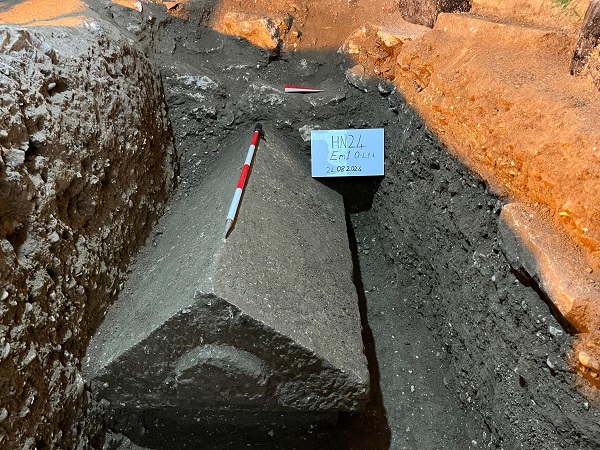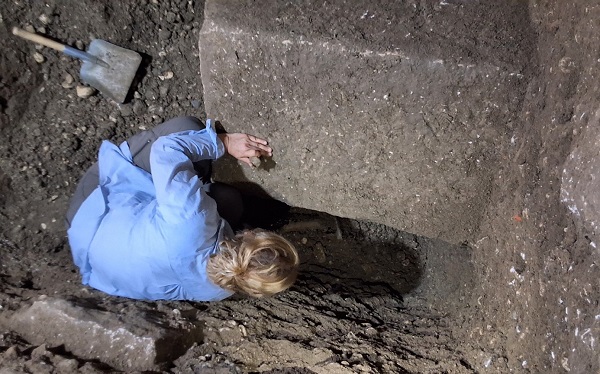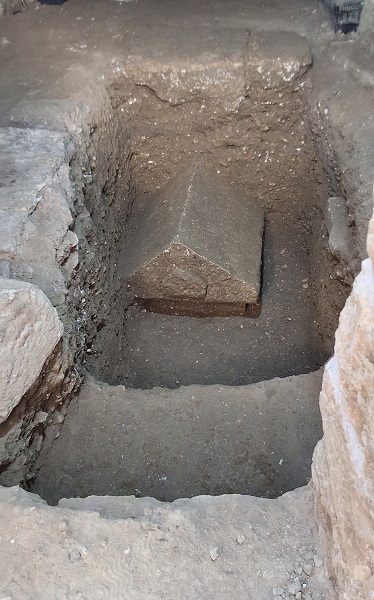A sarcophagus was unearthed at St. Nicholas Church in the Demre district of Antalya, Türkiye.
Excavation Head Assoc. Prof. Dr Ebru Fatma Fındık, a faculty member of Hatay Mustafa Kemal University’s Department of Art History, provided information about the excavation work at the church and said, “Within the scope of Türkiye’s Ministry of Culture and Tourism’s Legacy to the Future project, we are working inside the 20-meter-long, two-story structure that borders the church courtyard from the south.”
Assoc. Prof. Dr Ebru Fatma Fındık continued, “While drilling inside the structure, we encountered a surprise sarcophagus. This work, among the undecorated sarcophagus group, is made of local stone and has a slightly high barrel roof. The lid, which forms a semicircular protrusion on the narrow side, has a handle. The underground part of the approximately 2-meter-long sarcophagus is estimated to be 1.5-2 meters high. According to initial evaluations, its similarity to the types of sarcophagi in the region is striking. In addition, many terracotta oil lamp fragments and animal bones were unearthed before reaching the sarcophagus during the drilling.”
First in situ sarcophagus at the site
Assoc. Prof. Dr Ebru Fatma Fındık added, “We believe that we have encountered a sarcophagus to be in situ for the first time. The fact that a sarcophagus has been unearthed very close to the church that is thought to contain the tomb of St. Nicholas excites us greatly. As part of the project, we will be happy to complete the excavation and restoration of the area where the sarcophagus is located and contribute to our country’s tourism.”
About St. Nicholas
Although Santa is often pictured travelling the world on a reindeer-drawn sleigh, the places where Saint Nicholas was born and lived were Anatolia’s sun-soaked Mediterranean coast. His deep compassion for children has inspired Santa Claus, the figure of a sympathetic old man believed to deliver gifts to kids. Saint Nicholas was born around 300 CE in the Lycian city of Patara as the only child of a wealthy wheat merchant. Little is known about Nicholas’ life, but the legends are abundant. It is believed that he was performing miracles from a very young age. One legend recounts how he survived after being trapped under a church wreckage during his youth. His miraculous deeds continued into adulthood, with fanciful stories claiming he secretly provided dowries for three young girls by dropping money through their window or chimney, saved a ship from sinking, and even brought three dead children back to life. He became known for his generosity in helping people and secretly giving gifts, especially to children and sailors.
Renowned as the patron saint of children and sailors, Saint Nicholas left his hometown of Patara after some years and settled in the nearby city of Myra. Known as modern-day Demre, Myra was the capital of the Lycian civilisation for a while and a bishopric centre. Saint Nicholas served as the miracle-working Bishop of Myra for many years, leaving a legacy of kindness and faith. Today, Myra welcomes visitors with its Lycian-period rock tombs and intact Roman-period theatre. Saint Nicholas is believed to have passed away at 65 on December 6, 343, in Myra. The mourning Myrians built a church to honour his saintly memory and interred him in a sarcophagus as his final resting place. However, on the walls of which the miracles of St. Nicholas are depicted, this church was later ruined by an earthquake and raids and rebuilt as a domed church in the 9th century. The next most extensive church repair was performed in 1042 by the Eastern Roman Emperor IX Constantine and his wife, Zoe. Thanks to these efforts, St. Nicholas Church is one of the finest examples of Middle Eastern Roman architecture today. The church, which has been on the UNESCO World Heritage Tentative List since 2000, is also one of the most important locales of Christianity in Türkiye, and thousands visit it every year for pilgrimage. ///nCa, 10 December 2024 (in cooperation with the Embassy of Türkiye to Turkmenistan)


